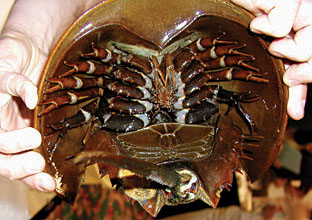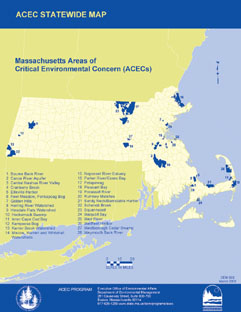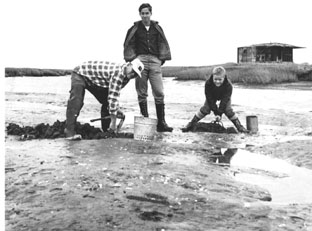
![]()
Volume 7, No. 3
Promoting Cooperation to Maintain and Enhance
Environmental Quality in the Gulf of Maine
|
||||||||||
|
|
|
|
|
|
|||||||
|
|
|
|
Browse the archive |
|
|
|
|
When some long-time Cape Codders ‘saw it coming’ they rallied to preserve a precious estuary
By Maureen Kelly
Nearly 20 years ago, Alan McClennen Sr., a retired town planner, was sailing his Dyna Craft 29’ between Cape Cod and Maine when his cruise was interrupted by a call from home. Get back here soon and go to work, some fellow Cape Codders urged him. They had lined-up a job for him that would put his work experience to good use.
These mostly older citizens had grown up around Pleasant Bay then moved away for jobs. After retiring they returned and found their home undergoing rapid change from development and population growth. Before the place they cared about became irreversibly altered, they enlisted McClennen’s help and formed Friends of Pleasant Bay (FOPB), a grassroots organization committed to preserving the one of the largest estuaries on Cape Cod.
If Cape Cod is roughly shaped like an arm curling into a fist, Pleasant Bay is located at the elbow. A long barrier beach, part of the Cape Cod National Seashore, protects the scenic bay from the full brunt of the Atlantic’s waves giving the bay and its inner islands a placid character.
The bay’s natural resources support fishing and shell fishing and are widely used for recreation and nature viewing. The bay also has significant cultural resources. Artifacts found there indicate that Native Americans may have inhabited Pleasant Bay as long as 10,000 years ago. Archeological sites around the bay range from ancient shell mounds to more recent vestiges of the European settlers who began arriving in the 17th century.
McClennen signed on as an officer of FOPB and he and his neighbors set out to persuade the towns of Chatham, Harwich, Orleans and Brewster to help get the bay listed by the state as an Area of Critical Environmental Concern (ACEC). The designation is possible through a program that allows any ten citizens to nominate areas with significant natural or cultural resources for increased protection. The effort was successful and, in 1987, the state designated the Pleasant Bay ACEC with over 9,000 acres of coastal habitat.
Creating a management plan
The ACEC victory marked the beginning of a long effort to plan for the stewardship of the bay. The designation does not prevent development, change zoning or effect land ownership. Rather, the ACEC program provides a framework for citizens, communities, organizations and agencies to work together to protect these areas over the long-term. Local stewardship groups, for instance, are encouraged to support planning efforts, research, land protection, mapping, inventories of natural resources and public outreach.
 |
| Friends of Pleasant Bay turned to biologists from Boston University’s Marine Program (BUMP) for an impartial study of the bay’s crab population, which they suspected were over-harvested. The crabs are a valued resource for the biomedical industry. The BUMP study provided baseline data that regulators can now use when making resource management decisions.
Photo: Andi Rierden |
His son Alan McClennen Jr., the current FOPB president, remembers the hard work that his father and others put into the effort.
“Designation is easy. The work begins when you begin to prepare the plan,” he said.
The FOPB led the process to create the management plan by fundraising, challenging the four towns to contribute money and hiring a consulting firm to prepare the actual document. The process took four years after which, in 1998, three of the towns adopted the plan and formed The Pleasant Bay Resource Management Alliance to implement it. Brewster is not participating, but McClennen Jr. hopes the town will one day join the Alliance, since much of the bay’s watershed is in Brewster.
Katie Lund, ACEC Coastal Stewardship Coordinator with the Massachusetts Office of Coastal Zone Management, credits the success in Pleasant Bay to overwhelming community support and awareness as well as the Alliance’s ability to bring the towns together.
“The towns deserve a lot of credit,” she said.
McClennen Jr. also believes that the multi-jurisdictional approach has been successful. It is one of the reasons, he believes, that the state approved their request for a bylaw prohibiting jet skis in parts of the bay while requests from other towns were denied.
 |
| ACEC map courtesy of David Kimball, GIS specialist, MA Department of Conservation and Recreation
Click on the map to enlarge |
Several years ago, after some local residents raised concerns over perceived over-harvesting of the bay’s horseshoe crabs, the FOPB turned to biologists from Boston University’s Marine Program (BUMP) for an impartial study of the bay’s crab population.
Once considered a nuisance because they fed on commercially important shellfish, there was a bounty of “a nickel a tail” on them into the early 1970s and little or no management of the crabs, said Ruth Carmichael, the lead BUMP researcher on the study.
In recent years, the crabs became a valued resource particularly for the biomedical industry, which harvests lysate from the crabs’ blood that can detect endotoxins contaminating medical equipment, and chitin—a component of the crab’s shell—that is used to coat sutures.
The BUMP study provided baseline data on the bay’s crab population that regulators can now use when making resource management decisions.
The FOPB also helped fund a study on terrapin turtles, which found that the changing and increasingly populated shoreline has adversely affected the animals, McClennen Jr. said.
Water quality and land preservation
Water quality testing in the bay by the Alliance and the FOPB has been raising awareness of the declining water quality and nitrogen-loading problem in small embayments.
The group is now supporting a land acquisition effort that will help protect the bay’s water quality by preserving 42 acres of land from development along the Monomoy River, which flows into the bay. The Trust for Public Land, which is assisting the Town of Harwich and the Harwich Conser-vation Trust to negotiate the purchase of the $5.8 million property, recently entered into a purchase agreement for the land. But, nearly $1.7 million must be raised by October for the deal to go through.
According to McClennen Jr., the Monomoy property is also a place of historic value as it was home to the last Native American to live at Pleasant Bay. Other sites of historic interest around the bay will likely be inventoried in the future. An April 2003 update to the resource management plan recommends that the Alliance develop a plan to protect the bay’s archeological resources.
 |
| Clam diggers on Pleasant Bay Photo courtesy of MA Office of Coastal Zone Management |
One of his priorities will be to significantly increase the FOPB’s membership by reaching out to “anyone who lives in the watershed.” He also hopes to track property transfers so that the FOPB can notify new homeowners that they have moved to an area rich in natural resources that must be protected.
“The life and health of the bay is a function of what people do in the watershed,” he said.
Maureen Kelly is a regular contributor to the Gulf of Maine Times. She lives in Reading, Massachusetts.